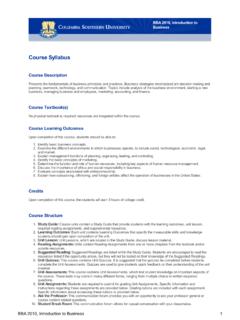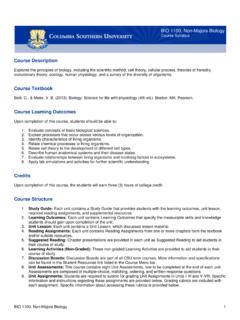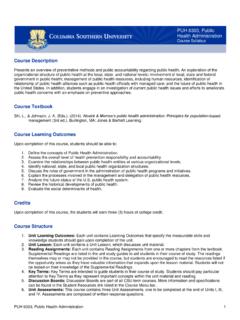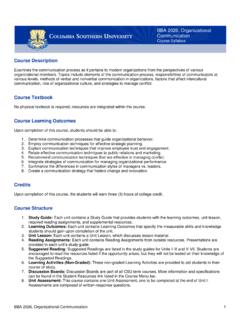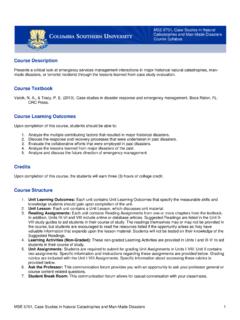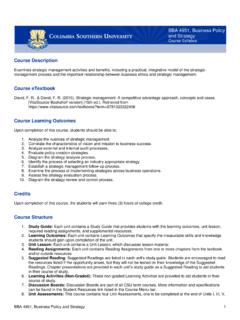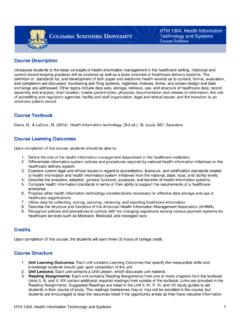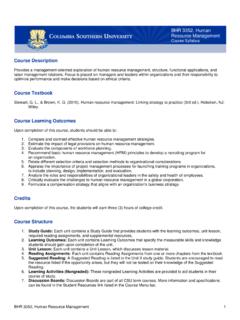Transcription of BCJ 3701, Criminal Investigation - Login - myCSU
1 bcj 3701 , Criminal Investigation 1 Course Description Presents a study of the development of the investigative procedures and techniques from early practices to modern-day forensic science capabilities with an emphasis on leadership, Investigation , and case preparations. Course Textbook Swanson, C. R., Chamelin, N. C., Territo, L., & Taylor, R. W. (2012). Criminal Investigation (11th ed.). New York, NY: McGraw-Hill. Course Learning Outcomes Upon completion of this course, students should be able to: 1. Outline the fundamentals and history of Criminal Investigation . 2. Analyze the Criminal Investigation process. 3. Examine the process for obtaining information, including interviews, interrogations, and surveillance. 4. Identify crimes against persons such as homicide, robbery, and assaults. 5. Examine missing person investigations and crimes against children. 6. Identify crimes against property.
2 7. Explain vice and profit-related crimes. 8. Describe the relationship between Criminal Investigation and the courtroom process. Credits Upon completion of this course, the students will earn three (3) hours of college credit. Course Structure 1. Study Guide: Each unit contains a Study Guide that provides students with the learning outcomes, unit lesson, required reading assignments, and supplemental resources. 2. Learning Outcomes: Each unit contains Learning Outcomes that specify the measurable skills and knowledge students should gain upon completion of the unit. 3. Unit Lesson: Each unit contains a Unit Lesson, which discusses lesson material. 4. Reading Assignments: Each unit contains Reading Assignments from one or more chapters from the textbook and/or outside resources. 5. Suggested Reading: Suggested Readings are listed in each unit s study guide. Students are encouraged to read the resources listed if the opportunity arises, but they will not be tested on their knowledge of the Suggested Readings.
3 6. Learning Activities (Non-Graded): These non-graded Learning Activities are provided to aid students in their course of study. 7. Discussion Boards: Discussion Boards are part of all CSU term courses. More information and specifications can be found in the Student Resources link listed in the Course Menu bar. 8. Unit Assessments: This course contains four Unit Assessments, one to be completed at the end of Units II, III, VI, and VII. Assessments are composed of written-response questions. 9. Unit Assignments: Students are required to submit for grading Unit Assignments in Units I, III, IV, V, and VIII. Specific information and instructions regarding these assignments are provided below. Grading rubrics are included with each assignment. Specific information about accessing these rubrics is provided below. bcj 3701 , Criminal Investigation Course Syllabus bcj 3701 , Criminal Investigation 2 10. Ask the Professor: This communication forum provides you with an opportunity to ask your professor general or course content related questions.
4 11. Student Break Room: This communication forum allows for casual conversation with your classmates. CSU Online Library The CSU Online Library is available to support your courses and programs. The online library includes databases, journals, e-books, and research guides. These resources are always accessible and can be reached through the library webpage. To access the library, log into the myCSU Student Portal, and click on CSU Online Library. You can also access the CSU Online Library from the My Library button on the course menu for each course in Blackboard. The CSU Online Library offers several reference services. E-mail and telephone ( ) assistance is available Monday Thursday from 8 am to 5 pm and Friday from 8 am to 3 pm. The library s chat reference service, Ask a Librarian, is available 24/7; look for the chat box on the online library page. Librarians can help you develop your research plan or assist you in finding relevant, appropriate, and timely information.
5 Reference requests can include customized keyword search strategies, links to articles, database help, and other services. Unit Assignments Unit I Case Study The case you are going to discuss is one that actually happened in the United States. The vital information has been changed or deleted to protect the identity of the agency, former law enforcement members, and locations. The case will soon be heard in state supreme court. The local police narcotics division received intelligence from a Criminal informant that a hydroponic supply shop in the area was growing marijuana and selling it in the shop during store hours and after hours. Narcotics detectives placed a camera for surveillance outside the shop s location. They followed one patron to his private residence. The narcotics detectives entered the patrons property several times over the course of two weeks by climbing a fence to get a clear view of the property and the inside of the house.
6 They found several marijuana plants, some growing equipment, and paraphernalia. Upon deciding that they had enough evidence to raid and make an arrest, the officers seized a DVD from a security camera that showed them climbing a fence to obtain access to the property. The sergeant in charge of the Investigation ordered the DVD destroyed. Shortly after this incident, the same narcotics officers disguised themselves as power company employees and municipal water workers to obtain records from both utilities to prove that a grow-house operation existed at a residence within their jurisdiction. They conducted surveillance of the residence in these uniforms as well as entered an office of the power company, disguised as employees, to obtain official records. Their justification for doing this was that they could smell a strong odor of marijuana from the residence adjacent to the residence in question as well as when they passed the residence on the sidewalk.
7 The narcotics officers utilized the camera system they placed across from the hydroponic shop to obtain license plates and addresses of people that stopped at the store. The narcotics officers utilized a tactic known as knock and talk, where they approached homes without a search warrant 84 times, knocked on the door, and talked to the residents. They stated that they believed the residents were growing marijuana and requested to search their homes. During those 84 times, they found marijuana 34 times but found nothing the other times. In several cases, they found hydroponic vegetables and fruit growing in the backyards and inside the apartments. This unit consisted of a sergeant, corporal, and two detectives. They later resigned to avoid internal affairs investigations. A defense attorney later determined that in the first case they illegally jumped/climbed the fence because there was no search warrant.
8 They were armed with their agency issued firearms in both incidents. The case is scheduled to be heard in the state supreme court next year. Write a two- to three-page report explaining what information in Chapter 2 of the textbook applies to this situation. Identify all legal concepts you feel need addressing. bcj 3701 , Criminal Investigation 3 Ensure you answer the following questions in your report: How does having a search warrant or not having a search warrant affect the outcome of this case? Does the added knowledge of the fact that the officers were carrying firearms onto private property with or without a search warrant have bearing on the case? When you consider that the narcotics officers entered a business dressed as employees, do you see this as a legal issue? Your paper must be written in APA style. If you utilize additional sources such as the Bill of Rights, the Constitution, or agency policy, these references must be cited correctly in a reference page that is not included in the total page count.
9 Information about accessing the Blackboard Grading Rubric for this assignment is provided below. Unit III Essay Discuss the importance of the landmark case Miranda v. Arizona. Now pick one of the following cases: Berghuis v. Thompkins, Maryland v. Shatzer, McNabb v. United States, or Minnick v. Mississippi, and discuss its significance to interviewing and interrogation. Is there a relationship between the case that you chose and Miranda v. Arizona? If there is, discuss that relationship as it relates to interview and interrogation. Your response should be at least 300 words in length. You are required to use at least your textbook as source material for your response. All sources used, including the textbook, must be referenced; paraphrased and quoted material must have accompanying citations. Information about accessing the Blackboard Grading Rubric for this assignment is provided below. Unit IV Research Report Access the CSU Online Library to find research information on homicide and death investigations.
10 You may choose among the following topics: women that kill, children (defined as under 21) that kill, spree killing, or school shootings. You are required to discuss two cases that are based on the topic you have chosen to research. You must have a minimum of four references. If you are utilizing a case you were personally involved in as a law enforcement officer or family member, then provide the documentation to the reference in the case. Your research paper must be a minimum of three pages in length, not including your title and reference pages. Please use proper APA formatting for your citations and references. Information about accessing the Blackboard Grading Rubric for this assignment is provided below. Unit V PowerPoint Presentation Prevention of Residential Burglary You are an officer assigned to the burglary unit. Your chain of command has requested that you speak to a home owners association (HOA) in reference to 20 burglaries that have occurred in a particular neighborhood during the past six months.

